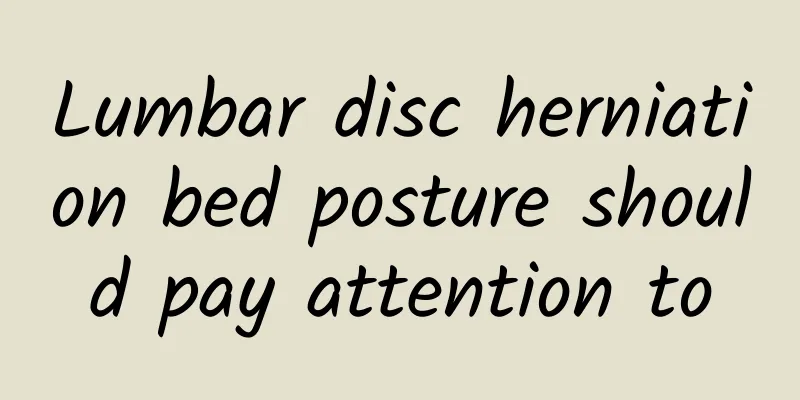Lumbar disc herniation bed posture should pay attention to

|
The harm of lumbar disc herniation is relatively large. For patients, they should pay attention to bed rest. They should also understand some precautions during the rest period. Whether the sleeping posture is correct not only affects the quality of sleep, but is also important for the health of the waist. When lying in bed, they should try to keep the waist in a natural physiological position. As a patient with lumbar disc herniation, it is best to sleep on a hard bed. Lumbar disc herniation bed posture should pay attention to Whether the sleeping posture is correct or not is not only related to the quality of sleep, but also to the health of the waist and the health of the whole body. A scientific and reasonable lying posture should try to keep the waist in a natural physiological curvature. The supine position can relax the muscles of the whole body of patients with lumbar disc herniation, significantly reduce the pressure in the lumbar intervertebral space, alleviate the posterior disc herniation, and reduce the tension of the iliopsoas muscles and sciatic nerve. This lying posture is most suitable for people with lumbar disc herniation or other lower back pain accompanied by sciatica symptoms. When lying on your side, you should bend your hips and knees. The ancients said that "sleeping like a bow" refers to this sleeping position, which can eliminate the extension of the waist and avoid or relieve low back pain. Patients with lumbar disc herniation should pay attention to the following points in their daily health care: ① Sleep on a hard bed. Sleeping on a firm bed can reduce the pressure on the intervertebral discs. When sleeping, it will be more comfortable to lie on your side with your knees bent. ② Keep your waist warm and try not to catch cold. Avoid catching cold and eating too much raw or cold food, and don’t stay under the air conditioner for a long time, as this is not good for your waist! Strengthen the protection of your waist and back. ③ Wearing a waist belt (waist protector) around your waist during the day is beneficial to the recovery of the lumbar spine. ④Stand regularly every day and slowly arch your back several times.⑤ Whenever you feel your back is tired, you should lie down or sit in a chair with a backrest to rest. ⑥ If you have a hunchback, you should keep your knees higher than your hips when sitting. This will help support your back. The soles of your feet should be able to fully touch the ground. Otherwise, you should put a small wooden stool under your feet or lower the height of the seat. ⑦ Whether you are standing, sitting or in any other posture, be sure to support your back at all times, especially when sitting in a car or plane for a long time. ⑧ When lifting heavy objects, do not bend over, but bend your knees to avoid excessive twisting of the body and sudden force. Pay attention to home care for lumbar disc herniation 1. Bed rest Patients with lumbar disc herniation should absolutely rest in bed for about a week after the onset of the disease. Generally, a hard bed is suitable, and the patient should lie in the supine position. This can promote blood circulation and relieve pain in the waist and legs. After 1 week, you can gradually get out of bed and do some light activities. After 2 weeks, you can do appropriate physical activities according to your condition. After 3-4 weeks, you can resume normal activities, but you cannot do heavy work or strenuous exercise. 2. Appropriate exercise: Patients can get out of bed after one week of absolute rest, hold the door frame with both hands, with both feet seemingly touching the ground but not touching the ground, and the body naturally hanging and relaxing, once a day in the morning and evening, each time for 5-10 minutes; patients can also lie in bed, hold the head of the bed with both hands, and move the toes towards the foot of the bed as much as possible, 1-2 times a day, each time for 10-20 minutes. If you persist for more than 2 weeks, the pain will be relieved. 3. Exercise the lumbar muscles. In the acute stage of lumbar disc herniation, patients should perform five-point support exercises in bed: lie on your back, use your head, elbows and feet as support points, lift your body upward for 2-5 minutes each time, twice a day; after one month, you can do three-point support exercises: lie on your back, use your head and feet as support points to lift your body upward for 4-6 minutes each time, twice a day. |
<<: Symptoms of female physique deficiency and coldness
>>: Bed rest posture after thoracic vertebra fracture
Recommend
How much water should be added when boiling Chinese medicine?
Traditional Chinese medicine and Chinese medicina...
What does sublingual varicose veins mean?
Sublingual varicose veins are generally not parti...
The main causes of bronchitis
There are more and more patients with bronchitis ...
The exact location of Sanyinjiao
Sanyinjiao acupoint refers to the intersection of...
Symptoms of dehydration due to acute gastroenteritis
The stomach is one of the organs in the body that...
The efficacy and effects of yellow Tongkat Ali
How to consume yellow Tongkat Ali and what are it...
What to do if you have trouble sleeping at night for a long time
If you don't sleep well at night for a long t...
What ointment promotes wound healing?
We all know that when a part of a person's sk...
Causes of high total cholesterol
It is well known that there are many components i...
The correct way to wash your face with white vinegar, so that it will not hurt your face
It is said that washing your face with white vine...
Where is the Mingmen acupoint?
Nowadays, people know that they should adopt Chin...
What acupoints should be massaged for anxiety
When anxiety disorder occurs, it is necessary to ...
What causes atrial rhythm?
Atrial arrhythmia is also a relatively common sym...
What is the medicinal value of Salsola
Salsola can lower blood pressure. Animal experime...
Feeling of eardrum vibration
Healthy ears will not have any problems, but unhe...









